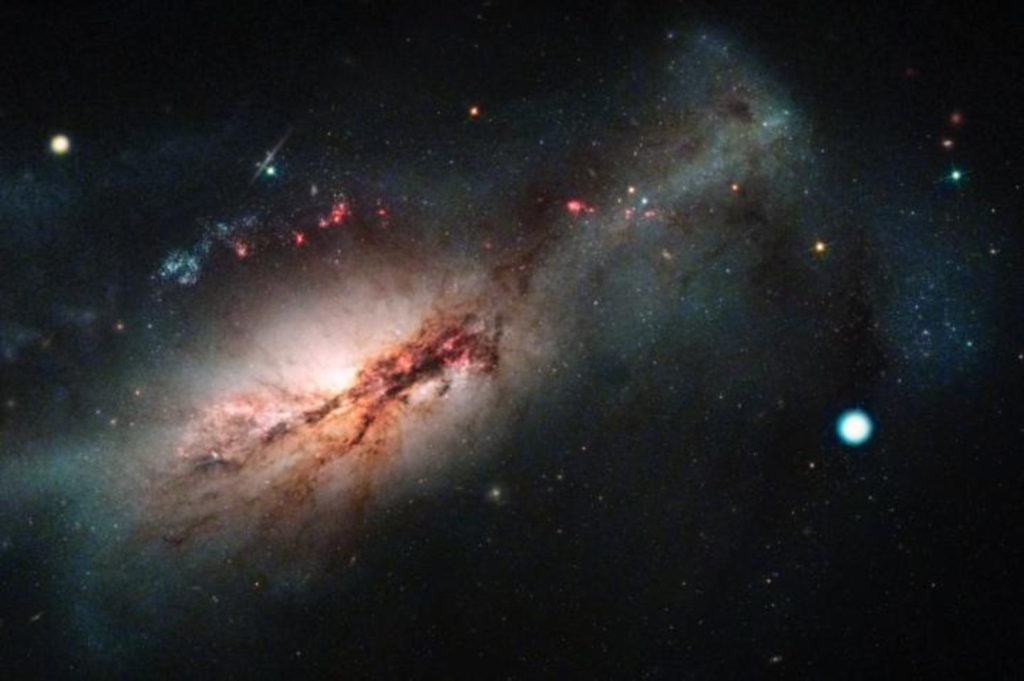
Las Cumbres/Hubble composite image of the electron-capture supernova SN 2018zd (the large white spot on the right) and the host starburst galaxy NGC 2146. Image credit: NASA / ESA / Hubble / STScI / J. DePasquale, Las Cumbres Observatory.
Using the Keck Observatory’s Low Resolution Imaging Spectrometer (LRIS) and DEep Imaging and Multi-Object Spectrograph (DEIMOS) attached to the 10 meter telescopes on Mauna Kea, we’ve observed a long-postulated, third type of supernova, an “Electron Capture” supernova.
It is believed, based on composite imaging across multiple spectral regimes, the famous Crab Nebula may have been one such supernova. The problem is, that event occurred almost a thousand years ago and any unique spectral features predicted to characterize this type of supernova are long since gone.
The supernova, SN 2018zd, occurred in the outskirts of NGC 2146, a barred spiral galaxy in the constellation Camelopardalis. As the name suggests, it was observed and recorded in 2018 and was relatively nearby at only 31 million light-years.
Type I Supernovae
Historically, there have been two main types of supernova, Type I and Type II, the former occurring, for example, when a parasitic white dwarf, accreting mass from a host main sequence star exceeds 1.4 solar masses (the Chandrasekhar mass). This results in a runaway thermonuclear chain reaction beginning on the surface of the white dwarf, obliterating both stars in one of the most energetic events in all of nature, a Type Ia supernova. Characteristic of this type of supernovae, evidenced by their spectra, is the plethora of heavy elements above silicon, iron, nickel and cobalt with a distinct lack of hydrogen or helium lines (it’s all consumed during the chain reaction – see illustration below).
Type II Core Collapse Supernovae
The second type, a Type II core collapse supernova, occurs when a high-mass star greater than 10 solar masses depletes its compliment of nuclear fuel, having completed a sequential series of increasingly heavy-element shell-burning cycles, synthesizing elements up to and including silicon. The silicon burning cycle lasts no more than 24 hours and synthesizes everything from sulfur up through and including iron, cobalt and nickel.
Unable to maintain the nucleosynthesis of increasingly heavy elements beyond Iron (caused by the chemically endothermic nature of Iron), the star’s core, its nuclear fusion reactor, shuts down, immediately ending all outward support thus causing the star’s outer core to collapse onto the degenerate nickel-iron inner-core at 30% the speed of light.
The considerable gravitational potential energy of the high-mass star’s core is thus converted into mechanical and heat energy as it implodes and rebounds off the degenerate inner-core. In doing so, the star is obliterated in the second most energetic event in all of nature, a Type-II supernova. Type Ia supernovae are generally more energetic than Type II supernovae.
The spectral characteristics of these supernovae are consistent with theory and observation: hydrogen and helium absorption lines combined with heavy-element emission lines. The outer core, contained within a bloated and distended hydrogen/helium shell, implodes in on the degenerate nickel-iron inner core, converting all the gravitational potential energy into mechanical and heat energy, energy that is absorbed by the extended hydrogen and helium shell, (SN 1992H), evidenced by characteristic hydrogen absorption lines.
No such Hydrogen or Helium lines are present in the spectra of Type Ia Thermonuclear supernovae (SN 1994HD) as it would all be consumed and transmuted into heavier elements.
Electron Capture Supernovae

Artist’s impressions of a super-asymptotic giant branch star (left) and its core (right) made up of oxygen (O), neon (Ne), and magnesium (Mg); a super-asymptotic giant branch star is the end state of stars in a mass range of around 8-10 solar masses, whose core is pressure supported by electrons (e-); when the core becomes dense enough, neon and magnesium start to eat up electrons (so-called electron-capture reactions), reducing the core pressure and inducing a core-collapse supernova explosion. Image credit: S. Wilkinson, Las Cumbres Observatory.
An electron capture supernova is a special case of a core collapse supernova and could conceivably be a subclass of a Type II supernova.
Stars are incredible self-regulating systems, maintaining their structure through hydrostatic equilibrium, a balance between the inward crush of gravity and outward facing gas and radiation pressure.
This inward crush of gravity is balanced by the outward gas and radiation pressure produced by the core nuclear fusion reactions. What keeps a star from collapsing under its own gravity is the energy produced in the core. In an electron-capture supernova, as the core runs out of fuel, gravity forces electrons in the core into their atomic nuclei, causing the star to collapse in on itself.
The mass necessary to accomplish this, to overcome the Coulomb repulsion between like, positively-charged protons and nuclei, in addition to violating more than one Quantum-mechanical principle, must be considerable and would necessarily exceed ten times the mass of the sun.
The Process
The same dynamic occurs in the formation of a neutron star.
All that remains supporting the enormous mass of the star nearing its end is the quickly-ending nuclear burning cycles and “electron degeneracy” pressure, a quantum-mechanical effect, a barrier to further collapse established by the Pauli Exclusion principle.
The result is an emergent pressure against compression of matter into smaller volumes of space. The inner core of a highly-evolved, high-mass star, described as “degenerate“, is supported by this outward pressure where further collapsed is inhibited for masses below 10 solar masses. A mass above this limit will overcome this barrier through “Electron Capture“, thus forcing electrons to combine with protons to form neutrons.
First predicted in 1980 by University of Tokyo astronomer Dr. Ken’ichi Nomoto, electron-capture supernovae are considered borderline cases between the two major types of supernovae.
According to Dr. Nomoto in the recently published paper
“In an electron capture supernova, some of the electrons in the oxygen-neon-magnesium core get smashed into their atomic nuclei in a process called electron capture. This removal of electrons causes the core of the star to buckle under its own weight and collapse, resulting in an electron-capture supernova.”
The team, led by by Daichi Hiramatsu, graduate student at UC Santa Barbara and Las Cumbres Observatory,
looked through all published data on supernovae and found that while some had a few of the indicators predicted for electron-capture supernovae, only SN 2018zd had all six markers: an apparent progenitor star of the Super-Asymptotic Giant Branch (SAGB) type, strong pre-event mass loss, unusual stellar chemical spectrum, a weak explosion, little radioactivity and a neutron-rich core.
Hiramatsu went on to comment:
“We started by asking ‘what’s this weirdo?’ Then we examined every aspect of SN 2018zd and realized that all of them can be explained in the electron-capture scenario,”
The original paper is published in the June 28, 2021 issue of Nature Astronomy.
Additional articles can be found on the Keck Observatory web portal and in Science News for June 29, 2021.
Astronomy For Change: https://astronomyforchange.org
Buy us a Coffee? https://www.buymeacoffee.com/astronomychange
Follow Us On Twitter: https://twitter.com/astronomychange
Why not support us on Patreon: https://www.patreon.com/astronomyforchange
Imagination is more important than knowledge
![]()
An index of all articles can be found here.
If you enjoyed this article, please consider supporting us with a modest donation
or through a subscription on our Patreon Page
Membership at Astronomy for Change is Free!




